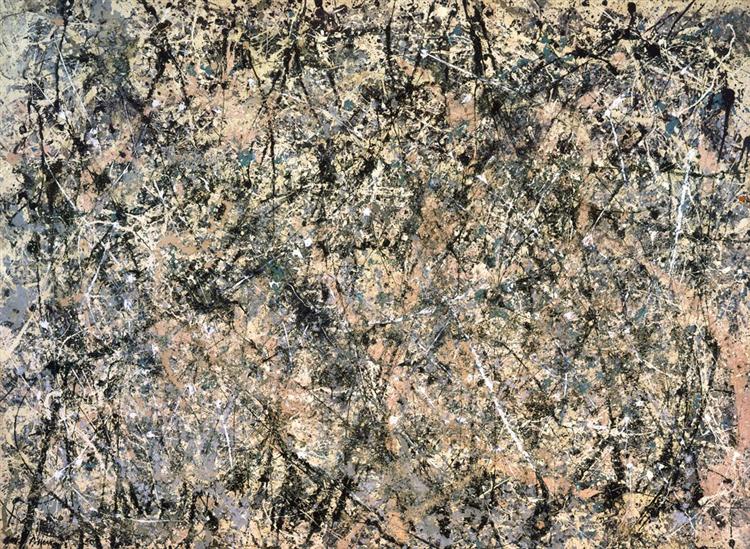
What is abstract expressionism? A guide to key themes, notable artists, and important artworks.
Abstract Expressionism is an American art movement that flourished in the 1940s and 1950s. It is characterized by its emphasis on spontaneity, emotion, and the unconscious, and it represented a radical departure from the representational and figurative styles that dominated art for centuries.
Abstract Expressionism was centered in New York City and became a dominant force in the postwar art world. Artists associated with this movement sought to express their inner world through their art, often using large-scale canvases to create dynamic and expressive works.
A defining characteristic of Abstract Expressionism is the emphasis on the artist's process and the physicality of the act of painting. Artists like Jackson Pollock, often associated with "action painting," dripped and splattered paint onto their canvases, creating intricate webs of color and texture. This approach challenged traditional notions of artistic technique and brought attention to the artist's body as a tool for creation.
While the movement encompassed a diverse range of styles, two primary tendencies emerged:
- Action Painting: Characterized by energetic and spontaneous brushwork, often involving the artist moving around the canvas.
- Color Field Painting: Focuses on large areas of flat, saturated color to evoke emotional responses.
Abstract Expressionism was deeply influenced by Surrealism, psychoanalysis, and existential philosophy. Artists sought to tap into the unconscious mind and express their deepest emotions through their work. The movement also reflected the cultural and social climate of post-war America, characterized by anxiety, uncertainty, and a search for meaning.
Though Abstract Expressionism had its heyday in the 1950s, its impact on subsequent art movements is undeniable. The movement's emphasis on individuality, experimentation, and the expressive potential of abstract form continues to resonate with contemporary artists.
Notable Artists
- Jackson Pollock (1912-1956) is considered one of the most influential figures of Abstract Expressionism. His "drip" paintings, such as "Number 5, 1948," are iconic examples of action painting.
- Willem de Kooning (1904-1997) was another key figure in the movement. His paintings, such as "Woman I" (1950-52), are characterized by their expressive brushwork and dynamic compositions.
- Mark Rothko (1903-1970) was a major exponent of color field painting. His works, such as "Untitled (Violet, Black, Orange, Yellow on White and Red)" (1949), are known for their large-scale rectangles of color that evoke powerful emotions.
- Barnett Newman (1905-1970) was another important color field painter. His "zip" paintings, such as "Vir Heroicus Sublimis" (1950-51), are characterized by vertical bands of color interrupted by narrow lines.
- Franz Kline (1910-1962) was known for his black-and-white paintings with bold, expressive brushstrokes. His work, such as "Composition No. 5" (1952), is a prime example of action painting.
- Robert Motherwell (1915-1991) was known for his "Open" series of paintings, which feature black shapes on a white background. His work, such as "Elegy to the Spanish Republic No. 118" (1967), is a powerful example of abstract expressionism.
- Clyfford Still (1904-1980) was a reclusive artist whose large-scale paintings are characterized by their raw, emotional power. His work, such as "1957-N Number 1" (1957), is a testament to the expressive potential of abstract art.
- Arshile Gorky (1904-1948) was an Armenian-American artist whose work bridged Surrealism and Abstract Expressionism. His paintings, such as "The Liver Is the Cock's Comb" (1944), are known for their biomorphic shapes and rich colors.
- Helen Frankenthaler (1928-2011) was a key figure in the development of color field painting. Her work, such as "Mountains and Sea" (1952), is characterized by her use of stain techniques, which allowed the paint to soak into the canvas.
- Joan Mitchell (1925-1992) was an American painter whose work is characterized by its lyrical and expressive quality. Her paintings, such as "La Vie en Rose" (1979), are known for their vibrant colors and dynamic compositions.
- Robert Rauschenberg (1925-2008) was an American artist who combined elements of Abstract Expressionism and Pop Art in his work. His "combines," such as "Bed" (1955), are assemblages of found objects and painted elements.
- Jasper Johns (1930-) is an American artist who emerged in the 1950s and challenged the dominance of Abstract Expressionism. His work, such as "Flag" (1954-55), is known for its use of everyday imagery and its exploration of the relationship between art and reality.
Key Characteristics
- Emphasis on spontaneity, emotion, and the unconscious: Abstract Expressionists sought to express their inner world through their art, often using their bodies as tools to create dynamic and expressive works.
- Large-scale canvases and expressive brushwork: The use of large canvases allowed artists to fully immerse themselves in the painting process and create works of monumental scale.
- Exploration of the artist's process and the physicality of painting: Abstract Expressionists emphasized the act of painting itself, often using unconventional techniques such as dripping, splattering, and pouring.
- Diverse range of styles, including action painting and color field painting: The movement encompassed a wide range of approaches, from the energetic brushwork of action painting to the serene expanses of color field painting.
- Influence of Surrealism, psychoanalysis, and existential philosophy: Abstract Expressionism was deeply influenced by these intellectual currents, which contributed to the movement's emphasis on the unconscious and the exploration of the human psyche.
Impact and Legacy
Abstract Expressionism had a profound impact on the development of modern and contemporary art, paving the way for new forms of artistic expression. The movement's emphasis on individuality, experimentation, and the expressive potential of abstract form continues to resonate with artists today.
Abstract Expressionism represents a pivotal moment in the history of art, marking a shift away from representation and towards a more subjective and expressive form of artistic expression.
Additional Resources